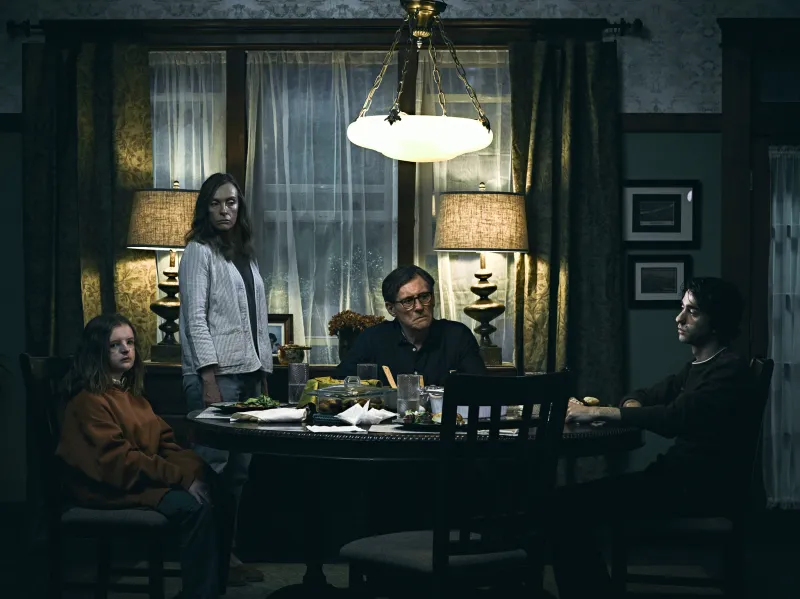In the visually and psychologically disturbing “Hereditary,” filmmaker Ari Aster blurs the lines between the effects of mental illness and a supernatural interpretation of reality.
The movie starts with a funeral: Grandma Leigh has died, and during the memorial service, her daughter, Annie, gives a difficult speech. Every member of the family, except for the youngest daughter Charlie, seems to be less grieved by the grandma’s death than secretly relieved. Later in the film, in a spontaneous and daring turn of events, the family’s son Peter accidentally causes the decapitation of Charlie, the decisive moment when the family dynamic completely crumbles. The movie is told mainly through Annie’s perspective: we see her attempt to deal with Charlie’s death by recreating a miniature scene (as she works as an artist that creates dollhouses), her dealing with a supernatural summoning of Charlie and her eventual collapse into madness (or, her understanding of the supernatural truth).
The line of mental illness is passed down through the family (hence the title “Hereditary”): The grandmother suffered from dissociative identity disorder and dementia (while at the same time participating in “private rituals”), Annie’s brother from schizophrenia (“my mother tried to put people in me”) and Annie from unnamed though heavily implied childhood trauma. In one of the most heartbreaking scenes of the movie, where Annie pleads with her husband Steve to burn Charlie’s notebook, we catch a glimpse of the removed view of Annie’s mental illness. In the first half of the movie, we primarily see the movie through Annie’s perspective, knowing what she knows, experiencing what she feels. However, when a hysterical Annie tells Steve that he has to burn Charlie’s notebook to save Peter, Steve’s face is set in a mix of disdain and fear. Therein lies the central tension of the movie: do the events that unfold result from the orchestration of the cult which seeks to summon Paimon? Or, are they because of Annie’s madness?
The Western concept of madness has been intrinsically tied with gender. The word “hysteria” finds its roots in the Greek word for “uterus,” eventually developing into the 19th century definition as a diagnosable mental illness in women. In the mid-20th century, the number of American women hospitalized for a mental illness far outnumbered the number of male patients. Likewise, the film’s depiction of female madness follows a history of literary and visual representation in this area — from the famous hallucinatory speech of Shakespeare’s Lady Macbeth (“Out, damned spot!”) to the unnamed woman in “The Yellow Wallpaper”’s freedom in her delusion.
On the opposing side of the mental illness interpretation lies the cult. The purpose of this cult is to worship King Paimon, a demon that serves Lucifer. Although the cult seemingly doesn’t appear until the second half of the movie, its presence is there from the start, the prime example being Charlie. The clicking sound that Charlie makes seems like an innocent (albeit strange) character quirk in the beginning, but eventually reveals itself to be a signifier of Paimon’s presence. We consistently hear the sound throughout the movie, and eventually Paimon comes to being through Peter’s body. “It is imperative to remember that King Paimon is a male, thus covetous of a male human body,” the cult’s book states. We learn early on that Annie, while trying to protect Peter, decided to give Charlie to her mother to raise (there is the disturbing detail here that the grandma also tried to breastfeed Charlie), and the two became extremely close. After learning of the grandma’s cultish intentions, it is implied that she had somehow transferred the demon Paimon into Charlie’s body. In that sense, the audience, and the Grahams, never got to know the real Charlie.
The ritual of summoning Paimon is completed through three decapitations: Charlie’s, the grandma’s and Annie’s. While the existence of the entire family seemed to be in service of some larger purpose (the starting shot of the movie portrays the characters in a dollhouse), the female body is especially futile: Charlie’s body was used as a temporary vessel for Paimon — his end goal is to transfer to a male body — and the decapitation of three women is in service of Paimon’s eventual rise.
The very graphic depictions of the three female decapitations (foreshadowed by Charlie’s/Paimon’s cutting off of a bird’s head) are reminiscent of literary traditions such as “The Green Ribbon,” and the more recent “The Husband Stitch” by Carmen Maria Machado. As French feminist Hélène Cixous writes, the “execution of woman” is represented by the “loss of her head.” In that sense, only when Annie saws off her own head does her identity completely disintegrate.
Though Ari Aster has given a definite answer to the different interpretations of how events in “Hereditary” unfolded (it was the cult), the depiction of mental illness as the conscious force that drives the collapse of the family still plays an important role. “Hereditary” is a movie that plays with the concept of reality as it relates to a gendered lens of mental illness.
Contact Emma K Wang at ekwang ‘at’ stanford.edu.
